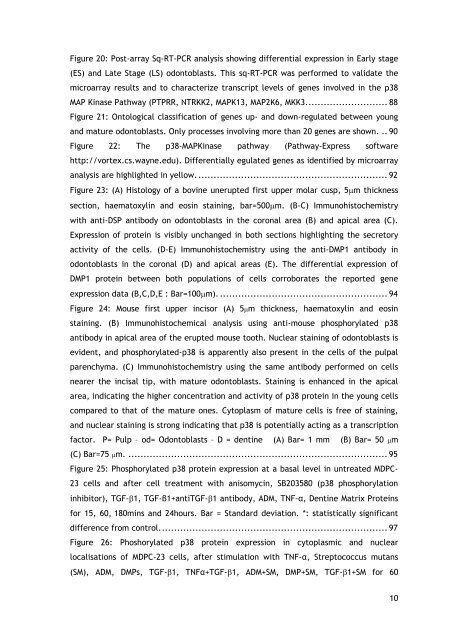Molecular characterisation of odontoblast during primary, secondary ...
Molecular characterisation of odontoblast during primary, secondary ...
Molecular characterisation of odontoblast during primary, secondary ...
Create successful ePaper yourself
Turn your PDF publications into a flip-book with our unique Google optimized e-Paper software.
Figure 20: Post-array Sq-RT-PCR analysis showing differential expression in Early stage<br />
(ES) and Late Stage (LS) <strong>odontoblast</strong>s. This sq-RT-PCR was performed to validate the<br />
microarray results and to characterize transcript levels <strong>of</strong> genes involved in the p38<br />
MAP Kinase Pathway (PTPRR, NTRKK2, MAPK13, MAP2K6, MKK3. .......................... 88<br />
Figure 21: Ontological classification <strong>of</strong> genes up- and down-regulated between young<br />
and mature <strong>odontoblast</strong>s. Only processes involving more than 20 genes are shown. .. 90<br />
Figure 22: The p38-MAPKinase pathway (Pathway-Express s<strong>of</strong>tware<br />
http://vortex.cs.wayne.edu). Differentially egulated genes as identified by microarray<br />
analysis are highlighted in yellow. .............................................................. 92<br />
Figure 23: (A) Histology <strong>of</strong> a bovine unerupted first upper molar cusp, 5μm thickness<br />
section, haematoxylin and eosin staining, bar=500μm. (B-C) Immunohistochemistry<br />
with anti-DSP antibody on <strong>odontoblast</strong>s in the coronal area (B) and apical area (C).<br />
Expression <strong>of</strong> protein is visibly unchanged in both sections highlighting the secretory<br />
activity <strong>of</strong> the cells. (D-E) Immunohistochemistry using the anti-DMP1 antibody in<br />
<strong>odontoblast</strong>s in the coronal (D) and apical areas (E). The differential expression <strong>of</strong><br />
DMP1 protein between both populations <strong>of</strong> cells corroborates the reported gene<br />
expression data (B,C,D,E : Bar=100μm). ....................................................... 94<br />
Figure 24: Mouse first upper incisor (A) 5μm thickness, haematoxylin and eosin<br />
staining. (B) Immunohistochemical analysis using anti-mouse phosphorylated p38<br />
antibody in apical area <strong>of</strong> the erupted mouse tooth. Nuclear staining <strong>of</strong> <strong>odontoblast</strong>s is<br />
evident, and phosphorylated-p38 is apparently also present in the cells <strong>of</strong> the pulpal<br />
parenchyma. (C) Immunohistochemistry using the same antibody performed on cells<br />
nearer the incisal tip, with mature <strong>odontoblast</strong>s. Staining is enhanced in the apical<br />
area, indicating the higher concentration and activity <strong>of</strong> p38 protein in the young cells<br />
compared to that <strong>of</strong> the mature ones. Cytoplasm <strong>of</strong> mature cells is free <strong>of</strong> staining,<br />
and nuclear staining is strong indicating that p38 is potentially acting as a transcription<br />
factor. P= Pulp – od= Odontoblasts – D = dentine (A) Bar= 1 mm (B) Bar= 50 μm<br />
(C) Bar=75 μm. ..................................................................................... 95<br />
Figure 25: Phosphorylated p38 protein expression at a basal level in untreated MDPC-<br />
23 cells and after cell treatment with anisomycin, SB203580 (p38 phosphorylation<br />
inhibitor), TGF-β1, TGF-β1+antiTGF-β1 antibody, ADM, TNF-α, Dentine Matrix Proteins<br />
for 15, 60, 180mins and 24hours. Bar = Standard deviation. *: statistically significant<br />
difference from control. .......................................................................... 97<br />
Figure 26: Phoshorylated p38 protein expression in cytoplasmic and nuclear<br />
localisations <strong>of</strong> MDPC-23 cells, after stimulation with TNF-α, Streptococcus mutans<br />
(SM), ADM, DMPs, TGF-β1, TNFα+TGF-β1, ADM+SM, DMP+SM, TGF-β1+SM for 60<br />
10
















